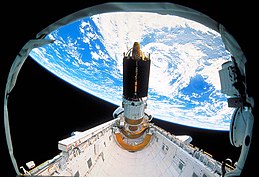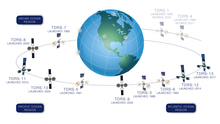
STS-70 was the 21st flight of the Space Shuttle Discovery, and the last of 7 shuttle missions to carry a Tracking and Data Relay Satellite (TDRS). This was the first shuttle mission controlled from the new mission control center room at the Johnson Space Center in Houston. STS-70 was also the first flight of the new Block 1 orbiter main engine, designed to improve both engine performance and safety. The mission was launched from Kennedy Space Center in Florida on 13 July 1995, only six days after the landing of sister ship Atlantis, marking the fastest turnaround between flights in the history of the program.

SBS 4 was a geostationary communications satellite designed and manufactured by Hughes on the HS-376 platform. It was ordered by Satellite Business Systems, which later sold it to Hughes Communications. It had a Ku band payload and operated at 94°W longitude.
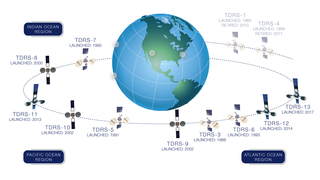
A tracking and data relay satellite (TDRS) is a type of communications satellite that forms part of the Tracking and Data Relay Satellite System (TDRSS) used by NASA and other United States government agencies for communications to and from independent "User Platforms" such as satellites, balloons, aircraft, the International Space Station, and remote bases like the Amundsen-Scott South Pole Station. This system was designed to replace an existing worldwide network of ground stations that had supported all of NASA's crewed flight missions and uncrewed satellites in low-Earth orbits. The primary system design goal was to increase the amount of time that these spacecraft were in communication with the ground and improve the amount of data that could be transferred. These TDRSS satellites are all designed and built to be launched to and function in geosynchronous orbit, 35,786 km (22,236 mi) above the surface of the Earth.
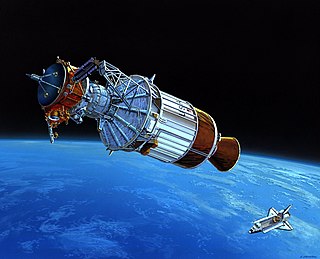
The Inertial Upper Stage (IUS), originally designated the Interim Upper Stage, was a two-stage, solid-fueled space launch system developed by Boeing for the United States Air Force beginning in 1976 for raising payloads from low Earth orbit to higher orbits or interplanetary trajectories following launch aboard a Titan 34D or Titan IV rocket as its upper stage, or from the payload bay of the Space Shuttle as a space tug.

Several significant events in spaceflight occurred in 2009, including Iran conducting its first indigenous orbital launch, the first Swiss satellite being launched and New Zealand launching its first sounding rocket. The H-IIB and Naro-1 rockets conducted maiden flights, whilst the Tsyklon-3, Falcon 1 and Ariane 5GS were retired from service. The permanent crew of the International Space Station increased from three to six in May, and in the last few months of the year, Japan's first resupply mission to the outpost, HTV-1, was conducted successfully.
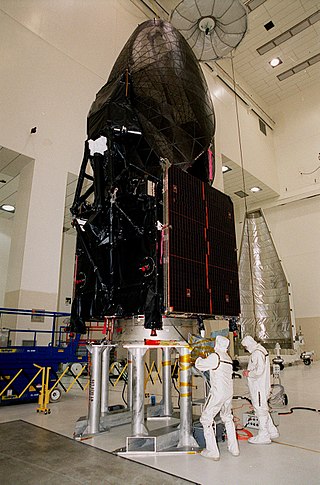
TDRS-8, known before launch as TDRS-H, is an American communications satellite, of second generation, which is operated by NASA as part of the Tracking and Data Relay Satellite System. It was constructed by Boeing is based on the BSS-601 satellite bus.

TDRS-B was an American communications satellite, of first generation, which was to have formed part of the Tracking and Data Relay Satellite System. It was destroyed in 1986 when the Space ShuttleChallenger disintegrated 73 seconds after launch.

TDRS-1, known before launch as TDRS-A, was an American communications satellite, operated by NASA as part of the Tracking and Data Relay Satellite System. It was constructed by TRW and launched by Space ShuttleChallenger on its maiden flight, STS-6.
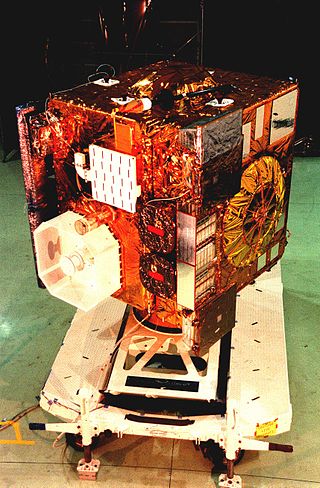
GOES-11, known as GOES-L before becoming operational, is an American weather satellite, which is part of the US National Oceanic and Atmospheric Administration's Geostationary Operational Environmental Satellite system. It was launched in 2000, and operated at the GOES-WEST position, providing coverage of the west coast of the United States, until December 6, 2011.

INSAT-1B was an Indian communications satellite which formed part of the Indian National Satellite System. Launched in 1983, it was operated in geostationary orbit at a longitude of 74 degrees east. At the end of its seven-year design life it was replaced by the newly launched INSAT-1D, dropping to backup status. In 1992, it was relocated to 93° east, before being decommissioned in August 1993.

TDRS-5, known before launch as TDRS-E, is an American communications satellite, of first generation, which is operated by NASA as part of the Tracking and Data Relay Satellite System. It was constructed by TRW is based on a custom satellite bus which was used for all seven first generation TDRS satellites.
Orion 3 was an American spacecraft which was intended for use by Orion Network Systems, as a geostationary communications satellite. It was to have been positioned in geostationary orbit at a longitude of 139° East, from where it was to have provided communications services to Asia and Oceania. Due to a malfunction during launch, it was instead delivered to a useless low Earth orbit.
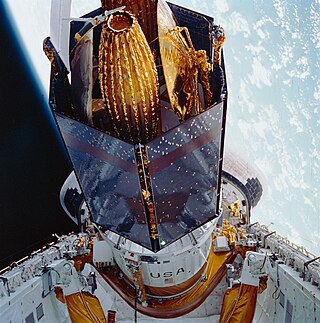
TDRS-3, known before launch as TDRS-C, is an American communications satellite, of first generation, which is operated by NASA as part of the Tracking and Data Relay Satellite System. It was constructed by TRW, and is based on a custom satellite bus which was used for all seven first generation TDRS satellites.

TDRS-6, known before launch as TDRS-F, is an American communications satellite, of first generation, which is operated by NASA as part of the Tracking and Data Relay Satellite System. It was constructed by TRW, and is based on a custom satellite bus which was used for all seven first generation TDRS satellites.

TDRS-7, known before launch as TDRS-G, is an American communications satellite, of first generation, which is operated by NASA as part of the Tracking and Data Relay Satellite System. It was constructed by TRW as a replacement for TDRS-B, which had been lost in the Challenger accident, and was the last first generation TDRS satellite to be launched.

TDRS-9, known before launch as TDRS-I, is an American communications satellite which is operated by NASA as part of the Tracking and Data Relay Satellite System. It was constructed by the Boeing Satellite Development Center, formerly Hughes Space and Communications, and is based on the BSS-601 satellite bus. It was the second Advanced TDRS, or second-generation Tracking and Data Relay Satellite, to be launched.

TDRS-10, known before launch as TDRS-J, is an American communications satellite which is operated by NASA as part of the Tracking and Data Relay Satellite System. It was constructed by the Boeing Satellite Development Center, formerly Hughes Space and Communications, and is based on the BSS-601 satellite bus. It was the third and final Advanced TDRS, or second-generation Tracking and Data Relay Satellite, to be launched.

GOES-3, known as GOES-C before becoming operational, was an American geostationary weather and communications satellite. It was originally built for the National Oceanic and Atmospheric Administration as part of the Geostationary Operational Environmental Satellite system, and was launched in June 1978. It was positioned in geostationary orbit, from where it was initially used for weather forecasting in the United States. Since ceasing to function as a weather satellite in 1989, it was used as a communications satellite, and spent over thirty-eight years in operation. GOES-3 was decommissioned 29 June 2016 at the Center for Southeastern Tropical Advanced Remote Sensing facility in Miami, Florida.

TDRS-11, known before launch as TDRS-K, is an American communications satellite which is operated by NASA as part of the Tracking and Data Relay Satellite System. The eleventh Tracking and Data Relay Satellite is the first third-generation spacecraft.
